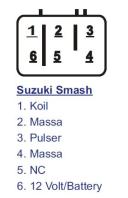After I had simulation and analysis, the conclusion of the modifications to the Smash CDI Smash is indeed there are differences in timing if refers to standard conditions of Smash CDI smash. But compared to Shogun CDI type (one pulser) then there is no difference in principle.
The problem is the Smash CDI is 2 input pulser type, then there is a timing difference of about half a period, let’s say we take the standard period CDI of 0.5 ms, then there is a difference of 0.25 ms timing.
During the testing seems to have no problem, either at low or high rpm usage during my everyday use. But based on earlier theory there might be a problem if the rpm is very high. It’s just that I do not know whether the difference in timing was much slower or faster. I’m gonna need oscilloscope to test this.
If the difference in timing before the timing standard or much faster than standard timing, I think this will be better for high rpm because we no longer need to advance the timing.
Anyway the important thing is I can use it for daily use without any problem and I have to use it. I don’t wanna waste my money 😀
Here is the picture of the CDI Smash connector.
Here’s the original CDI image sequence analysis.
Can we see above … the signal generator produces an AC sine signal with a frequency of 1 Hz and amplitude is 10 VAC (this just for example, not the real data). The signal from the signal generator is passed to a transformer as a pulser replacement circuit … We can see from the picture that when one of the pulser (green) maximum, the other end of the pulser / mass pulser (red color) has the same value in opposite phase (negative .) So CDI requires two opposite phase input.
And the following image analysis with a series of replacement
By adding two diodes in the input + (pulser) and input-(mass), then we could put the Smash CDI on Supra.
Can be seen from the picture above, when one end of the pulser positive other end is zero, and when the other negative other end is zero.
From the above picture we can see there are a half-wavelength difference between each pulse.
Conclusion:
- Until now I do not know its characteristics of the IC being used, whether the IC take into account the amount of input from the input signal or just based on a period of time.
- If the input quantities are also taken into account (such as OP-AMP IC), there will be a reduction in output value (half) of the standard value
- There will be a timing difference of about half a period, but if the IC work like an op-amp and no need two input voltage and it’s seem like that for smash (for some CDI like Fiz-R need two inverting input signal), there will be no timing difference, but the output maybe reduced. It depend on it’s IC characteristic.




Wah kebeneran nih jd pgn tanya..Sebenernya CDI smash itu CDI AC/DC bos?Yg saya tau kalau pengapian ada kaber dari 12volt/aki ke CDI itu termasuk CDI DC bos,,Tapi kalau baca postingan si bos ane rada mumet bin bingung,setau ane supra fit pake CDI AC coz pake tenaga supplay dr spull tp koq supra bs dipasangin CDI smash ya??Bos emang bnr" orang genius bs ngerubah hal" yg ga mungkin dipasang malah jd antik dipasang.O y libur posting jgn kelamaan bos ane tunggu jwbn postingan pertnyaan dari ane bos..
Yg makin aneh nih bos,,Yang pake CDI AC bs dipasang CDI DC masa jupi ane kalah saing dipasang sesama DC mlh ga mau nyala bener" aneh nih dunianya he..he..he..
CDI smash ya DC mas… full DC…CDI AC ataupun DC itu fungsinya sama aja… bedanya CDI AC pake tegangan/arus dari spull buat membangkitkan tegangan tingginya (yang ke koil), sedangkan CDI DC menggunakan Aki melalui sebuah inverter DC-AC (di dalam CDI).Kalo supra pake CDI DC seperti smash, ya gak perlu lagi pakai kabel dari spull, karena dah dapat dari aki. Bisa dilihat artikel CDI dengan NE555, atau lihat di nauval2007-moto.blogspot.com
yup… aku sendiri belum sempet riset jupie…apalagi sekarang jarang ngoprek motor… tapi emang sepertinya jupie gak cocok ma yang lain
Ping-balik: Tricks: Install Smash CDI on Supra ,stAidbands™
Ping-balik: How to Install Smash CDI on Supra | | Staidbands™